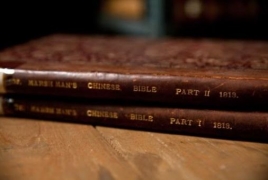 Interesting facts about Armenian-Chinese tiesArmenian merchant authored first Chinese translation of Bible PanARMENIAN.Net will tell about Hovhannes Ghazarian, who became one of the first translators of the Bible into the Chinese language. There are no Armenian sources referring to Hovhannes Ghazarian, more known as Joannes Lassar. The information about his courtesy we possess nowadays has originated from notes by English missionaries, who worked in China and India. PanARMENIAN.Net - According to them, Ghazarian was born in 1781 (or 1778) in the city of Makao, China, to a family of rich Armenian merchant. Besides native Armenian, he learned the southern Chinese dialect with the help of servants, who lived in the house. He also mastered Portuguese and English. A perfect Chinese speaker, he even worked as a translator at a Portuguese governmental office in Makao and held official correspondence with Chinese authorities. He was also engaged in teaching and trade. At that time, Christian missionaries from England, especially Protestants, intensified their activity in South and Southeast Asia, while translators were rated as professionals who could make Bible available and understandable for the locals. Fort William College that was founded in Kolkata in1800 was also supposed to train translators, thus making India a center for translating the Bible into local dialects and the Chinese language as well. It’s noteworthy that the first attempts to translate Christian literature into Chinese date back to Middle Ages. There exist some handwritten extracts from Bible translated at that time. At the beginning of the 19th century, missionaries undertook a task to get complete translation of the sacred book. However, the peculiarities of the Chinese language made translation a hard job and initial efforts failed halfway. In 1804, Joannes Lassar arrived in Kolkata, where the vice-provost of Fort William College, Claudius Buchanan, learning about the merchant’s Chinese language skills, offered him to translate the Bible. Lassar, who experienced financial problems at the moment, agreed to do the job for 300 Indian rupees (450 pounds) annual fee. He was later joined by missionary Joshua Marshman, his two sons and the son of the college provost. To do the translation, Lassar used the Armenian and English versions of the Bible, as well as a Portuguese-Chinese dictionary. In 1807, Lassar and Marshman moved from Kolkata to a neighboring city of Serampore, where they completed the translation of Gospel of Matthew and sent it to the Archbishop of Canterbury, who was supposed to take it to Lambeth Libraries. During the following years, Lassar and Marshman continued to translate the other testaments. In 1810, the gospels of Matthew and Mark were published in Serampore, while the next year saw the complete translation of the New Testament, which was published in 1813. The books caught the eye with a high quality translation and beautiful calligraphy. Besides, to make biblical names sound appropriate in Chinese, the translators created new additional hieroglyphs. Hovhannes Ghazarian’s work was appreciated by his contemporaries. Thus, on September 13, 1806, Fort William college provost, reverend David Brown wrote in his letter: “Professor Lassar sent me three samples of his Chinese translation of the Bible. Although the editions were published in hustle and I would not criticize them in principle, I must say that Mr. Lassar knows Chinese perfectly and the job he is doing will be a triumph if he has several more years to complete it. He reads the Bible in Chinese so fluently, like you would do it in English. He also writes very quickly.” Simultaneously with Lassar and Marshman, a protestant activist, Robert Morison, was also working on the Chinese translation of the Bible. Although, they were competing in some way, they consulted each other on some professional matters. In 1813, Morison’s translation of the New Testament was published in the city of Guangzhou (Canton). 10 years later, the translation of the whole Bible was published in Malacca (currently the territory of Malaysia). However, a year earlier, in 1822, the translation of the sacred book made by Lassar and Marshman came out in India. Experts say this was the best ever Chinese translation of the Bible. There is little known about the life of Hovhannes Ghazarian after that period. According to some sources, he died in 1820s; others say he lived till 1835. Literature: Stephen Neill, A History of Christianity in India: 1707-1858, Cambridge, 1985 Elijah Coleman Bridgman, S. Wells Williams, The Chinese Repository, vol IV, Canton, 1836 Ching Su, The printing presses of the London missionary society among the Chinese, London, 1996 Claudius Buchanan ,Two discourses preached before the University of Cambridge, on Commencement Sunday, July 1, 1810, Boston, 1811 Daniel Jeyaraj , Embodying Memories: Early Bible Translations in Tranquebar and Serampore, International bulletin of missionary research David Helliwell /Curator of Chinese Collections, Bodleian Library/, The earliest missionary editions, SERICA, some notes on old Chinese books, January 2013. Samson Hovhannisyan / PanARMENIAN.Net The Oscar-winning helmer who hopes to return to Armenia many, many times ICAE2018 proves a success Telling a story in a single image Chance to have another dream The other side of music How Indians turned into Armenian Gypsies Armenian Renaissance |